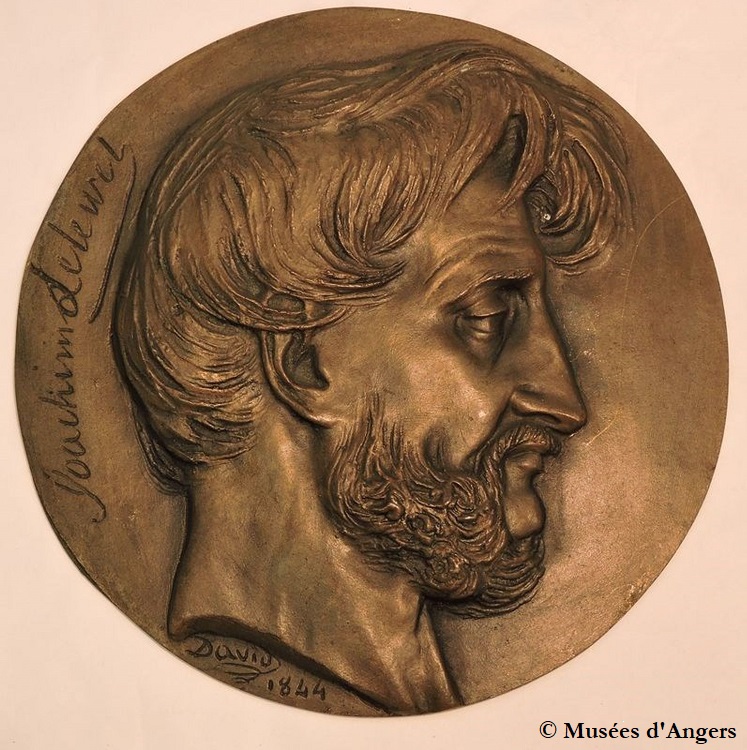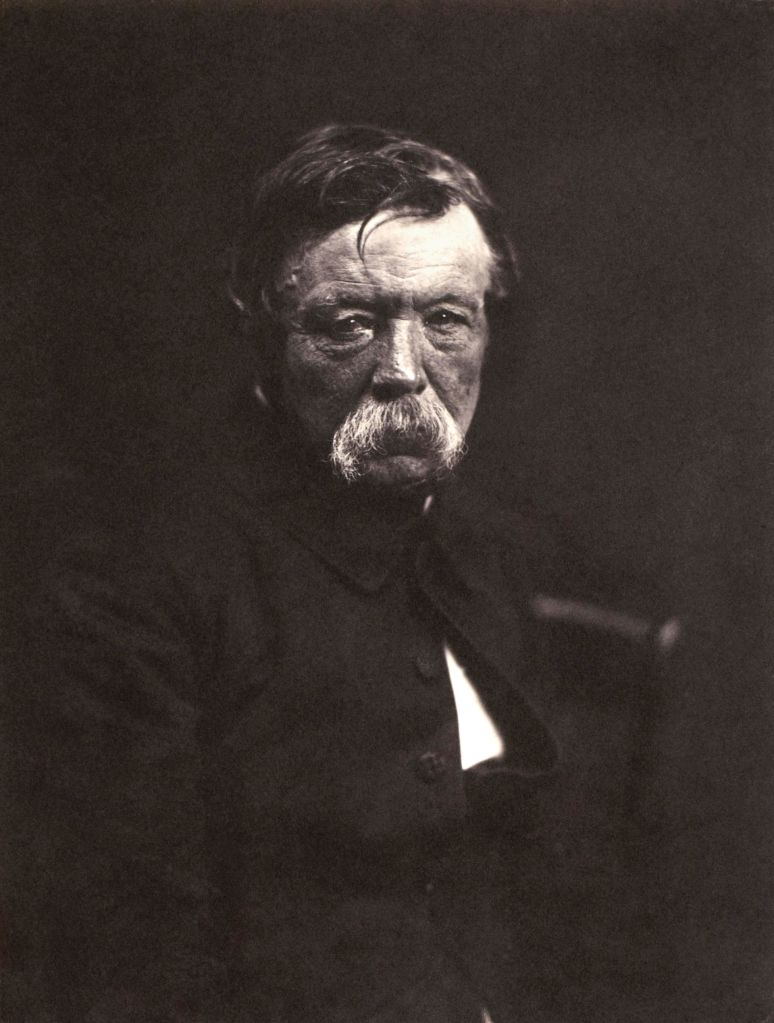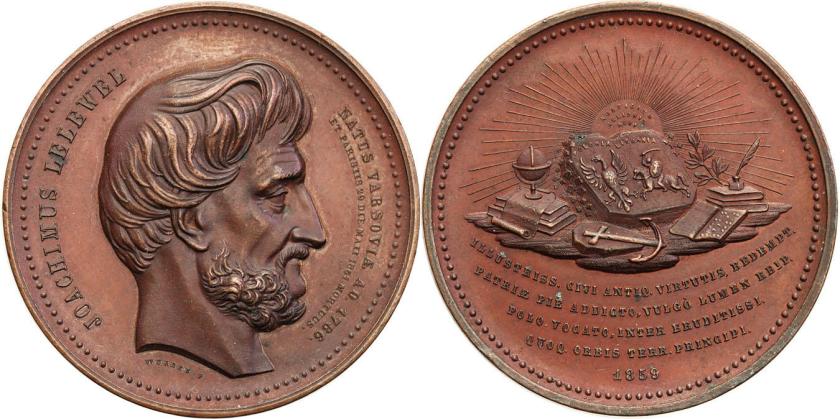
Bronze medal, 16.2 cm, of Joachim Lelewel, uniface, by David d’Angers, 1844.
Joachim Lelewel, the esteemed Polish patriot, numismatist, historian, and geographer, has left an indelible mark on the field of medieval numismatics through his extensive research, publications, and profound expertise. Today, I had the pleasure of delving into an article from years past, which provided invaluable insights into Lelewel’s character and accomplishments (button links to article in original French and translation below). It is my fervent belief that Lelewel’s humility and modesty, virtues often lacking in today’s prominent figures, serve as a refreshing reminder of authenticity and integrity.
One striking aspect of Lelewel’s character was his remarkable aversion to having his portrait drawn or otherwise commemorated. Despite the fervent demand for his likeness from his countless admirers, he tenaciously resisted such endeavors. Nevertheless, his resolve was eventually breached, leading to the creation of one of the most renowned portraits of Lelewel—the medal by David d’Angers (1788-1856), a highly skilled sculptor and medallist of the 19th century.

David d’Angers in 1853, photograph by Édouard Baldus
In an enlightening passage from the article, Lelewel’s correspondence sheds light on the creation of the medallion by David:
In the same collection of letters [written by Lelewel], we find some interesting details regarding the large medallion that David made of Lelewel. The few sentences we encounter in his letters show how much Lelewel avoided any publicity or external displays, even from his friends and his own family.
In response to a question posed by his brother Jean about his portrait, Lelewel replied on December 8, 1844: “I conclude this long letter with a little news that will let you know that if you won’t have the painting, at least you will soon have the satisfaction of seeing me in bronze. The very famous sculptor David has been making various efforts for a long time to obtain my profile. Recently, he stayed in Brussels and came to my place with a pencil in hand. I didn’t have the possibility to show him the door or snatch his pencil away, but he didn’t reach his goal without difficulties.[1] Finally, you will have me in bronze, rejoice!”
Jean became impatient and asked about the medallion. But there was no sign of life from David. “Has David done anything? I don’t know. He hasn’t sent me anything, but I’ve heard that he had other urgent works,” Lelewel wrote.[2] “I’m finally sending you two plaster medallions sent by David; they will certainly break at my place. If you want the one in bronze, come and get it yourself.” On January 20, 1846, Lelewel wrote, “David refused to make a portrait of the Prince of Orleans, but he sculpts vagabonds.”
Lelewel’s admirers made several medals in his honor, but the old loner was not at all proud. In one of his many letters,[3] he writes in a moment of good humor: “The Belgians steal from me; there is no doubt that my ‘facies’ is my material and intellectual property. They respect this property in such a way: Hart struck a large medal. Three copies of the small medal were brought to me by the Schoors brothers, wealthy numismatic enthusiasts whom I did not know before. Geefs, one of the top sculptors here, often came to my place without being invited. I thought his visits had a purpose and that he came to steal from me. It’s done! He told me that he has an order for a copy of my bust in alabaster for Volhynia or Podolia.” What Lelewel tells us about the difficulties he caused David when he wanted to draw his profile is perfectly true. He created difficulties for anyone who wanted to paint his portrait. Such cases often arose, as many of his Belgian and Polish admirers desired to have his likeness. From another source, we learn about the portrait of our scholar painted by Jean van Eycken. The widow of a friend of Lelewel, Mrs. Casimir Korybut-Daszkiewicz, was determined to have the portrait of this great patriot. As we know, it was not easy. But Jean van Eycken accepted the proposal and succeeded in painting the portrait through a trick. He painted through a partially opened door during a long conversation that Lelewel had with a Belgian democrat who was in on the secret. In this oil painting, Lelewel is depicted standing, his right hand resting on a cane, and his left hand placed behind his back in a gesture familiar to him. He is dressed in a blue working blouse. This portrait was later purchased by Chopin’s nephew, Colonel Henry Jedrzejewicz, who lived in Paris.
We also know of another portrait painted without Lelewel’s knowledge in 1854 by Guminski. This time, he is depicted sitting while drawing one of his geographical maps, with his left hand also behind his back. In the background, several shelves with books can be seen, as well as a chair holding his hat and handkerchief. Numerous photographs of this portrait were spread throughout Poland, and the original belonged to Jozefowicz, who resided in Paris.
[1] The drawing by David is in print room of the Royal Library of Brussels.
[2] Letter of May 1845.
[3] Letter of December 15, 1858.
The pencil drawing created by David is extant. It was used to create the medal at the start of this posting.

Pencil drawing of Joachim Lelewel by David d’Angers, 1844.
The enduring impact of David’s medal of Lelewel resonated profoundly, inspiring numerous other artists to adopt his image for their own portraits. It is not difficult to find examples of other medallists who drew inspiration from David’s creation. Two notable examples immediately come to mind…

Bronze medal by Hart, 1858. H-Cz. 3932.

Bronze medal by Wurden, 1859. H-Cz. 5393.
The legacy of Joachim Lelewel includes not just his scholarship but his unwavering modesty and aversion to public display. The latter remain integral facets of his character that continue to captivate our imagination. His refusal to be immortalized in portraits and the anecdotes surrounding his resistance only serve to enhance our admiration for this exceptional man, whose contributions to numismatics and historical research endure to this day.

